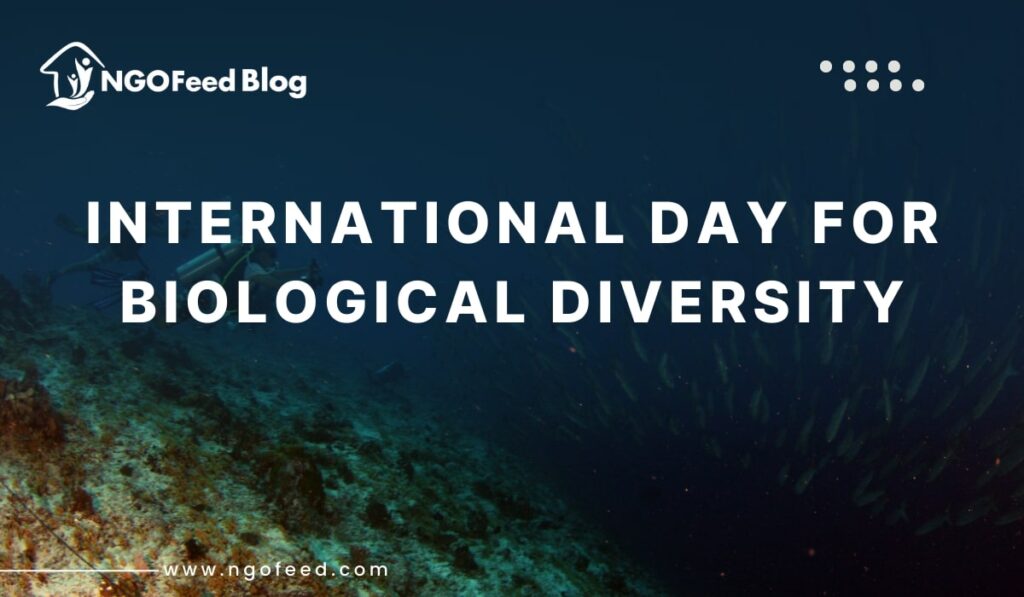International Day for Biological Diversity: Underlying human societies’ survival and advancement is biodiversity, which includes the diversity and variability of lifeforms at the genetic, species, and ecosystem levels. It offers vital ecosystem services, including clean air and water, pollination of crops, climate control, disease resistance, and cultural values that help economies and guarantee resilience against environmental disasters.
This observation serves as a call for quick, cooperative, and transformational action in an age when the health of the world is under great threat from unchecked urbanization, deforestation, habitat degradation, pollution, and climate change. It presents a vital chance for governments, organizations, communities, and people to rediscover their dedication to sustainable living and biodiversity preservation.
Table of Contents
International Day for Biological Diversity Origin and Historical Setting
The origin of this day may be found in the worldwide environmental consciousness that gathered pace in the late 20th century. Among the main results of the 1992 Earth Summit in Rio de Janeiro was the United Nations Convention on Biological Diversity (CBD). Using its components sustainably and guaranteeing the fair and equal sharing of benefits resulting from genetic resources, it represented a historic multilateral agreement meant to preserve biological variety.
The International Day for Biological Diversity was originally celebrated on 29 December, the day the CBD came into effect. But the United Nations changed the date to 22 May in 2000 to commemorate the day the CBD was first accepted in 1992 and to avoid conflict with year-end celebrations. Two-two May has developed into a significant day on the international environmental calendar.
Also Read: Best Practices for Sustainability in NGOs
Goal of the International Day for Biological Diversity
Among the main goals of this world event are:
- Increasing public knowledge about the crucial role of biodiversity in maintaining life on Earth.
- Educating the public about the reasons and effects of biodiversity loss.
- Policy makers are encouraged to create and execute legislation and systems that are biodiversityfriendly.
- At personal, local, and corporate levels, advocating for sustainable behavior.
- Promoting multilateral agreements and international cooperation to conserve species and ecosystems.
With these objectives, the day highlights that biodiversity is a critical and current need for survival and development rather than a far-off issue.
Theme for 2025: “Biodiversity for Resilient Futures” (Hypothetical)
Every year, the UN chooses a theme to coordinate worldwide events with urgent environmental and development problems. The theoretical 2025 theme, “Biodiversity for Resilient Futures,” stresses the pressing need to revive and preserve biodiversity as the foundation of society’s resilience.
In this sense, resilience refers to the ability of ecosystems and people to adjust to financial insecurity, pandemics, food poverty, and climate change. Biodiversity now concerns maintaining livable planet, stable economies, and good societies in addition to natural preservation.
Also Read: Role of NGOs in Sustainable Development
Importance of biodiversity
More than just a species count, biodiversity is a vibrant, connected system guaranteeing:
- Food Security: Different crop species and animal breeds improve resistance to pests and nutritional value.
- Biodiversity is a fountain for pharmaceutical invention; over 80% of the population of the earth depends on plant-based medications.
- Critical carbon sinks and buffers against severe storms, forests, wetlands, coral reefs, and oceans
- Cultural and Spiritual Identity: Indigenous and local civilizations have strong threads of biodiversity in their customs, beliefs, and way of life.
- Economic growth: Ecosystems help sectors like forestry, tourism, fisheries, and agriculture.
- The deterioration of biodiversity, however, erodes these systems and threatens all life, including human life.
Worldwide Biological Variety Crises
One of the most serious losses of biodiversity the 21st century has seen is acceleration. The Intergovernmental Science-Policy Platform on Biodiversity and Ecosystem Services (IPBES) released a report in 2019 stating that roughly 1 million animal and plant species are endangered with extinction, many of them in decades.
Among the causes of this crisis are:
Also Read: Role of NGOs in Sustainable Agriculture
- Land-use modifications (e.g., deforestation, agriculture)
- Overexploitation of natural riches
- Pollution (plastic, chemical, and air)
- Climate change
In response to this, there have been demands for a “transformative change” in world systems. The adoption of the Kunming-Montreal Global Biodiversity Framework in 2022, with 23 action targets for 2030, is a global blueprint to stop and reverse biodiversity loss.
Observance of customs and festivals
The day is celebrated around the world in many different projects:
- Educational Institutions: Seminars, biodiversity excursions, exhibitions, essay contests, and student-led awareness campaigns are all arranged by schools and universities.
- Ministries and environmental departments organize national campaigns, publish biodiversity reports, and highlight conservation successes as part of government programs.
- Common community projects include seed-saving events, tree-planting campaigns, wetland clean-ups, and local knowledge-sharing initiatives.
- Organizations use hashtags like #BiodiversityDay, #ForNature, and #ActForBiodiversity on social media to broadcast messages.
- Science and Policy Dialogues: Experts meet at events to brainstorm ideas, present studies, and keep an eye on worldwide goals.
These events try to involve people at all levels—personal, organizational, and governmental.
Also Read: Role of NGOs in Wildlife Conservation
India’s part in biodiversity preservation
With 7–8% of all known species worldwide, India is a megadiverse country. It has:
- About 45,000 plant species and over 91,000 animal species
- A vibrant legacy of Indigenous customs of sustainable use and community-led conservation, including sacred groves.
- Legislation and institutions in India comprise:
- Biological Diversity Act, 2002
- National Biodiversity Authority (NBA)
- Boards on state biodiversity (SBBs)
- Registers of people’s biodiversity (PBRs)
India has also started projects like the National Mission on Biodiversity and Human Well-being to incorporate ecological considerations into public health, education, and sustainable development.
Role of Young People and Civil Society
Leading the movement for biodiversity and the environment are the youth. They involve themselves in:
- Eco-clubs and school awareness campaigns
- Volunteer initiatives for ecological rehabilitation
- Science Communication and Digital Storytelling
- Projects of citizen science including species documentation using tools like iNaturalist
Through NGOs and grassroots campaigns, voices from excluded communities are amplified and ecological justice is advanced by connecting biodiversity to human rights, equity, and livelihoods.
Ahead the Road: Hope and worldwide action
Reversing biodiversity loss calls for the following from the planet:
- More cooperation between countries
- Policy systems founded on science
- models of green economy
- Respect for Indigenous and local knowledge systems
- Behavioral transformation across all levels of society
Also Read: Role of NGOs in Disaster Relief
Particularly Goals 14 (Life Below Water) and 15 (Life on Land), the 2030 Agenda for Sustainable Development is essential for the worldwide vision of “living in harmony with nature.” The new biodiversity strategy provides hope, but reaching its lofty goals demands accountability and true dedication.
Conclusion
The choice is ours: either to keep down a course of decline or to chart a fresh course of reverence, restoration, and renewal as we stand on the threshold in global health. A future that is safe, robust, and resilient depends on diversity. Let’s individually and collectively act to preserve the living web supporting us all.



